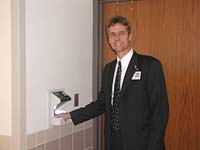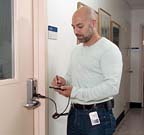Positive identification of people who come into a building is near the top of Dennis Lacey’s list.
“We needed a positive identifier for people carrying out critical county functions at off-hours,†says Lacey, security coordinator for Chesterfield County, Va.
Cost was the reason for Doug Ortiz’s recent access choice. Ortiz, locksmith supervisor at New York’s Memorial Sloan-Kettering Cancer Center, wanted to upgrade door access, save money and heighten accountability of users in the facility.
For Larry Kaplan, networkability was important. Kaplan, the national director of the America Search and Rescue Foundation, also wanted to print access cards from various locations.
What customers want – not surprisingly – varies from buyer to buyer, application to application, and organization to organization.

Closer Dealer-Customer Relationship
However, there is some commonality, according to a survey bySDM. Conducted online in early January 2004, the survey sought purchasing factors, future needs, tips to follow and pitfalls to avoid, according to the corporate, commercial and government buyers surveyed.Buyers expect their security dealer or systems integrator to provide site reviews and ways to talk with previous customers who have an access system similar to the one proposed. Customers expect a solid explanation of features ranging from software and readers to off-shelf hardware from their dealer.
“Be more job specific and not so brand-specific,†says one security manager at a major northeastern healthcare facility, who did not want to be identified. “The most important thing I look for in shopping for a dealer when I am shopping for new access control gear is that the dealer really understand my needs and match their work to my project’s scope.â€
Scott Nystrom with the U.S. Coast Guard in Boston, has simple advice for his end-user colleagues. “Do your homework. Check various products and vendors, too.â€
According to the SDM “What Customers Want†study, changing access needs of the organization and problems with a current system are the two most important reasons a buyer will purchase a new or different electronic access control system. Some also look at an upgrade to take advantage of security and building systems integration, while fewer than one in 10 of those buyers surveyed say they likely will break out the checkbook based on the introduction of new technology that catches their eye.
But take care, says Tim Powell of Coors Brewing Company, Golden, Colo. Powell advises his end-user colleagues to avoid proprietary access software and components. “Take the time to visit a site or two and talk with the day-to-day end-users.â€
Ongoing Product Need Reviews
The assumption that customers review their system needs once a year, and tie the review to the creation of next year’s budget, seems somewhat misplaced. About half of the executives who participated inSDM’s“What Customers Want†survey say they conduct an ongoing review of their access system, especially in relation to changing organization needs and new technology.When considering the purchase of a new or different access system, customers mostly share the feeling that reliability, price, integration, service and maintenance are important. When push comes to shove, however, most buyers believe that system reliability is the most important consideration in a purchase, while fewer view system integration as most significant.
Getting down to software, at the heart of many access advances, the bottom line for most buyers is Windows-based, networkable software that complies with typical communications and computer standards and protocols. One customer said the biggest pit he fell into was buying an access system that could not grow as his organization expanded, because it could not work with other internal systems as the need arose.
Specific to future access card needs, customers want a workable balance of higher level security and convenience for their system users. That boils down to proximity cards, smart cards and multiple technologies on one card. The latter is one way end-users can integrate internal systems; for example, proximity for door access, magnetic stripe for the cafeteria and bar code for time and attendance.
Regardless of the complexity or extent of an access control purchase, it is obvious that there continues to be a strong and evolving relationship between integrators and their customers.
“Show me the system, not just on paper, but in actual use,†Nystrom says; while a major corporate buyer in Canada adds that getting advice from an independent dealer, integrator or consultant will cost more going in but will pay off in installation, training, integration and customization.

Sidebar
Top Reasons
Customers
Purchase Access
• My organization needs changed.• I have a problem with my current system.
• I need to integrate with other systems.
Sidebar
‘Take My Advice’
Security dealers and systems integrators may gain insight from reviewing tips that buyers of electronic access control products offer to their colleagues.· Think twice about going with the lowest bid.
· How easily can the access system integrate with everything else?
· Do not totally relay on salespeople or a manufacturer, who will try to sell you what they have and not always what you need. Spend money upfront with an independent dealer, consultant or integrator.
Make sure you buy a system that will handle future needs and chose the best equipment your budget dollars will allow.
Sidebar
What Customers Want:
Purchasing Factors Vary Most important factors:
Reliability of system 16%
Integration 14%
Price 14%
Service, maintenance 14%
System’s ability to grow 11%
Open system platform 8%
Easy, quick installation 8%
Work with current gear 7%
Recommendations 5%
Brand name of system 2%
When push comes to shove, top two factors:
Reliability
Integration
Source: SDM, “What Customers Want,†based on an online survey of end-user buyers as represented by SECURITY Magazine subscribers, January 2004.
Sidebar
What Customers Want
When It Comes to Software One most important factor:
Network ability 26%
Standard, protocol compliance 22%
Windows-based 19%
Open architecture 17%
Off-shelf software 15%
When push comes to shove:
Half of customers review their current
access system on an ongoing basis.
Source: SDM, “What Customers Want,†based on an online survey of end-user buyers as represented by SECURITY Magazine subscribers, January 2004.
Sidebar
‘Don’t Make
My Mistake’
Buyers of electronic access control components and systems share purchasing pitfalls, to help dealers and integrators understand their needs.Don’t skip the recommendations of other buyers. Take the time to visit two sites where the equipment you intend to purchase is already in operation.
Don’t let someone else do your homework. Of course you depend on the technological knowledge base of a dealer or systems integrator, but take the time to know enough – ask tons of questions. Never assume.